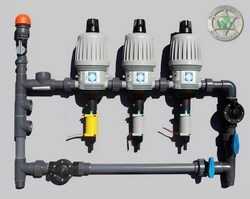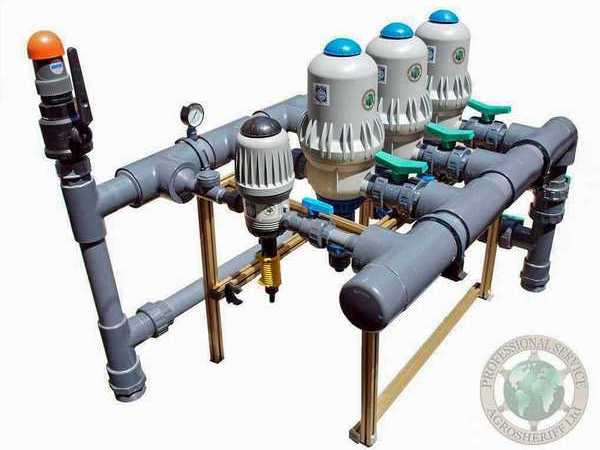PRACTICAL FERTIGATION
FERTIGATION ( fertigation ) - is a way of fertilizer plants by supplying dissolved fertilizer with irrigation water.
This technology is widely used among farmers around the world in the late 1970s. The use of fertigation was a natural and effective step in the development of agriculture, and developed techniques and methods of fertilizer application to power plants allowed to successfully apply this system in irrigated areas, using existing irrigation equipment.
Fertigation in hydroponics.
Hydroponic technology based on the use of neutral organic or mineral substrates not containing nutrients and, in some cases, for example when running hydroponic substrate is completely absent. How in these conditions provide power plants? There is only one way - to ensure receiving minerals simultaneously with irrigation. We use special mortar units - units or blocks of fertigation.
Technology Industry hydroponics has been developed over 30 years ago and is widely spread in different countries, but only in the large greenhouse complexes. The reason for the use of such systems mainly on large farms was the fact that the cost of equipment for fertigation units has been and remains quite high. Despite the long-term use in hydroponics fertigation systems, the cost of the equipment has not declined, but the actual equipment itself has not changed much in its design.
Our company always pays attention to the introduction of modern technology to small and medium enterprises. Often interested in our equipment and those for whom the cultivation of plants is just a hobby. But unfortunately, many people can not be ordered traditional equipment for fertigation because of its high cost.
We have set ourselves the task to develop a reliable, efficient, simple, and inexpensive system for fertigation farms of different sizes. Our fertigation units operating successfully in small amateur hydroponics installations and large-scale farms, and not only in greenhouses but also in large areas of open ground. The basic working of our body systems, fertigation is proportional dosing pump MixRite which provides precise, proportional addition of fertilizers in irrigation water and works without additional sources of energy, which dramatically simplifies the system and increases its reliability.
BASIC PARAMETERS UNITS fertigation
In each case, for given conditions of fertigation, you must take into account several important parameters :
- The maximum and minimum flow of the nutrient solution at a time.
- The number of nutrients added to the nutrient solution.
- The need to adjust the acidity of the nutrient solution.
With these settings, you can configure the system correctly fertigation virtually any requirements for such systems.
Additionally, it is possible to take into account the factor which will be operated by a fertigation system, such as in a greenhouse or outdoors in farmers' fields.
Water consumption:
Proportional dosing pumps manufactured MixRite bandwidth from 1.0 to 25.0 cubic meters of water per hour. Using these pumps, the order, our company manufactures components fertigation capacity from 1.0 to 125.0 cubic meters of water for maximum throughput. Digital from 1.0 to 125.0 cubic meters, displays the maximum flow of water through the assembly fertigation, but these nodes are in a very wide range of flow rates while maintaining accurate proportional dosage of nutrients.
For example, the fertigation unit designed for a maximum flow rate of 2.5 cu.m. / Hr has a range of from 30 to 2500 liters per hour while maintaining the exact proportions of fertilizer dosages.
The number of components of a fertilizer mixture :
For each area of application nodes, fertigation needs a unique approach. If a node is used to feed plants in the ground, in some cases quite a fertigation unit consisting of one dosing pump. Typically, it is served by complex fertilizers for the overall plant nutrition. Since the plants are grown in open ground, allowed some variation in the nutrient solutions, because the soil has large enough buffer properties and through fertigation system for open ground can be different types of fertilizers to file periodically, such as a few days of feeding is one type of fertilizer, and the next few days - to others. This is certainly not the best way to fertigation, but agog soil can be considered acceptable. If we apply multiple dosing pumps, then we have a full opportunity to fully balanced fertigation and plant nutrition. This is particularly important when it is necessary to adjust and change the composition of fertilizers relative content of individual nutrients. For various phases of plant, development is quite an important indicator since plants need to supply the various elements and their proportion varies depending on their development phase, and the external environment.
The acidity of the nutrient solution :
The acidity of the nutrient solution largely affects plant growth and development, as the acidity of water, soil or substrate depends on plant nutrient digestibility, since some types of fertilizer to pass common plant forms. Usually, the optimal level of acidity of the water and soil is considered an indicator Ph = 5,0-6,0 units, but very often, the water used for irrigation has an alkaline reaction in the range of 6.0 to 8.0. Such water with an alkaline reaction takes many kinds of nutrients in forms that are not readily available to plants. Moreover, such a negative effect on water irrigation system components as contained therein calcium salts are deposited as solids on the pipes and irrigation elements overflow - or dropper to the outlets' sprinklers. These deposits gradually clog the outlet structures and the irrigation system fails.
To acidify the nutrient solution used specialized acid dosing pumps that accurately balance the nutrient solution is fed to irrigate plants. This allows the plants to create the most favorable conditions for their development, significant cost savings, incidentally, keep your sprinkler system in working order for many years.
Especially fertigation for hydroponics :
Hydroponic technologies require a more thorough approach to applied fertigation systems. Neutral, Low-volume substrates do not contain the nutrients, and because of the limited volume have a low coefficient of buffering, that is, they almost do not accumulate and are not stored nutrients. In this regard, the feed solution should comprise the whole range of nutrients required for the growth and development of plants. Since the plants for their full-scale development requires about a dozen chemical elements, this is not possible, that would serve all of these types of fertilizers with the help of one of the metering pump. Node for hydroponics fertigation must have a minimum of 2 dosing pump for supplying different kinds of fertilizer, plus a third pump - acid to balance the acidity of the nutrient solution is going to the plants.
CLASSIFICATION OF UNITS fertigation
Nodes fertigation produced by our company is divided into two types: serial and parallel. They differ in how inclusion in the metering pumps. It depends on the specific technological requirements for the fertigation system, the number of components added to the nutrient solution, and the total required capacity of the system of irrigation.

A simple sequential fertigation block for hydroponics. 3 sequential metering pumps. Productivity is up to 2.5 cubic meters. in hour.

Single dosing pump for a small greenhouse or suburban area. Productivity is up to 1.0 cubic meters. in hour.

Parallel fertigation system for large areas of open ground. Productivity is up to 33.0 cubic meters. in hour.
How to calculate the required performance of the fertigation system:
The calculation of the productivity of the fertigation unit is determined by the water consumption of the irrigated area. Water consumption depends on the irrigation systems used for irrigation. For example, you need to irrigate your farm field. Drip tubes have been laid on a 1-hectare field. Pipes are laid every 80 cm, which is 125 pipes, with a plot size of 100x100 meters. The total length of drip lines is 12,500 meters. The distance between the droppers is 33 cm. The total number of droppers in the entire irrigated area will be 12,500x3 = 37,500 droppers. With a water flow through 1 dropper, for example, 1.6 liters per hour, the total water consumption will be 37500x1.6 = 60,000, that is, 60 cubic meters per hour. Thus, you will need a fertigation system of appropriate performance. But such a system is quite expensive. How to reduce the cost of a project?
The problem can be solved in several ways. For example, use a drip tube with lower water flow through the droppers. If we use a drip tube with a water flow rate through the droppers equal to 0.8 liters per hour, we can reduce the hourly water consumption by half, and then we need a fertigation unit with a capacity of 30 cubic meters. There is another way to reduce hourly water consumption - to divide the irrigated area into several irrigation zones. For example, 4, 6, or 8 irrigation zones that will be watered sequentially. In this case, the productivity of the fertigation unit will also decrease. It will decrease as many times as you have divided your area into irrigation zones. It's just that the watering time will increase proportionally since all the irrigated areas will need to be watered one by one.
The fertigation unit for greenhouse irrigation is calculated in the same way.
Be careful and scrupulous when calculating your irrigation system. All components and components of your system must be accurately calculated and correspond to the general parameters of water consumption per unit of time. The irrigation system includes a pump for supplying water, a filter, a fertigation unit, a second fine filter, which is installed after the fertigation unit, and when broken down into several irrigation zones it is necessary to provide an automation system that will automatically distribute water to the irrigation zones.
To control the composition and parameters of water supplied for irrigation, it is necessary to use special devices. EC meter - to control the total amount of salts in water and a Ph-meter to control acidity.